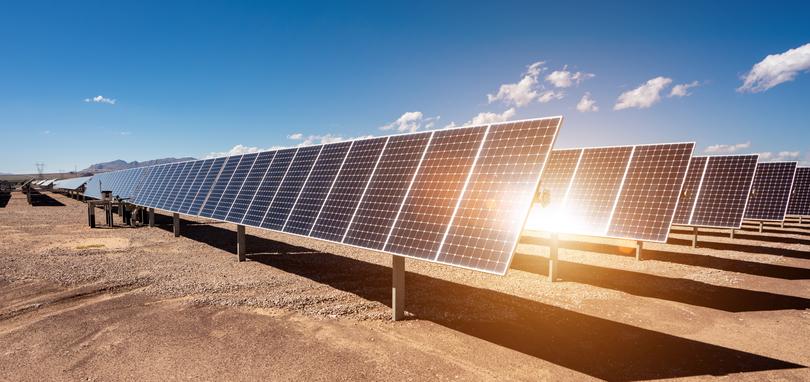THE ECONOMIST: Perovskite crystals may represent the future of solar power

It is commonly claimed, and also true, that enough sunlight falls on Earth in the course of an hour to meet a year’s worth of global power needs. Some of that sunlight is currently converted into electricity by arrays of solar panels: by the end of 2023, these panels covered almost 10,000 square kilometres of Earth’s surface, producing some 1,600 terawatt-hours of electricity, about 6 per cent of that generated worldwide.
The amount of installed solar capacity has been doubling roughly every three years. This is happening as the silicon-based solar cells used in the panels have been getting cheaper with intense competition among firms in China, which with state support have come to dominate the industry.
At the same time, researchers have found ways to make the cells better at absorbing the energy in sunlight. Modern solar panels operate with efficiency rates of 22-24 per cent — a massive increase from the 6 per cent achieved when the first practical solar cells were invented in the 1950s at Bell Labs in New Jersey, and were so expensive they mostly powered satellites.
Sign up to The Nightly's newsletters.
Get the first look at the digital newspaper, curated daily stories and breaking headlines delivered to your inbox.
By continuing you agree to our Terms and Privacy Policy.Yet most processes have their limits. The maximum theoretical efficiency of a silicon solar cell — the amount of energy in sunlight that is turned into electricity — is around 29 per cent. The rest of the solar energy is lost as heat. This theoretical maximum is only possible in laboratory conditions.
In addition, when cells are packed together into solar panels, the total efficiency of the panel is unlikely to get above 26 per cent. This is partly because the spaces between cells and other parts of the panel, such as the frame, do not contribute to making electricity. There are also inevitable losses of energy in the wires connecting the cells.
The future of solar power, however, could lie in a new, more efficient, type of solar cell that has just gone into production. Made with a family of crystalline materials called perovskites, they are capable of delivering panels with practical efficiency rates well above 30 per cent.
Jumping the gap
Traditional solar cells typically contain two layers of ultra-pure silicon, both doped with an additive to make them semiconducting (the ability to work as either a conductor or insulator). As they absorb light, electrons receive enough energy to jump across the junction between the layers, producing an electric current. Although other semiconductors can do the same, none rivals the affordability of silicon, which is produced cheaply from sand.
The original perovskite is a mineral called calcium titanium oxide. It was discovered in 1839 and named after Count Lev Perovski, a Russian mineralogist. The name has since become a generic term for substances with a similar crystalline structure.
One of the things that make perovskites so attractive to researchers as an alternative to silicon is that, in addition to being efficient at absorbing the energy in sunlight, they can also be made cheaply from easily obtainable materials, including a number of metals and halogens, like chlorine, bromide and iodine.

Although their light-absorbing superpowers have been known for some time, they have been difficult to harness, not least because perovskites degrade quickly and can be susceptible to moisture. Researchers are, therefore, searching for ways to make them more stable and adapt manufacturing processes to protect the cells from the elements.
One of the leaders in developing perovskite panels is Oxford PV, a British company based near the eponymous university where its research activities began. The firm has developed so-called tandem cells, which consist of a thin layer of perovskite placed on top of a traditional bed of silicon.
The idea is that the two materials working together can extract a greater amount of energy from sunlight than each could individually. To do so, the perovskite layer above is tweaked to absorb light from the blue end of the spectrum while the silicon layer underneath mops up the wavelengths at the red end, explains Chris Case, the company’s chief technology officer.
The firm has opened a factory in Germany which has just started to supply the first commercial tandem-cell solar panels to its first customer, an unnamed utility in the United States. The panels are being installed, along with conventional silicon units, at a new grid-connected solar farm. This will provide perovskites with their first big test at this scale, not just for efficiency but also durability and longevity. As silicon panels are expected to continue working for 20-25 years, perovskites must demonstrate similar lifespans.
The first production panels have an average efficiency of 24.5 per cent, adds Dr Case. A new generation under development has reached 26.9 per cent, and this is expected to increase to well over 30 per cent as research continues. The theoretical efficiency limit for a perovskite tandem cell in a laboratory is around 43 per cent (compared to the 29 per cent for silicon) although that is also unlikely to be reached once it is integrated into a panel.
Tandem cells will, initially, cost a bit more, although commercial prices have not been disclosed. With increasing production volumes, however, economies of scale will kick in and lower costs. The ability to deliver more power than traditional silicon panels means a tandem-cell installation should start to provide a return on investment much earlier than silicon-only panels, says David Ward, Oxford PV’s chief executive.
Other companies are close to commercialising their versions of perovskite-on-silicon solar panels. Hanwha, a big South Korean industrial group, has invested 137 billion won ($152m) in a factory to make tandem cells for its QCells range of solar panels. At the lab-scale, the firm says individual cells have achieved a maximum efficiency of 29.3 per cent, which would allow their new panels to be significantly better at producing electricity.
Not surprisingly, Chinese suppliers are also busy exploring perovskites. The current world record for a lab-based perovskite tandem cell is 34.6 per cent. This was claimed in June by LONGi Green Energy Technology, a big Chinese solar-cell manufacturer.
It began working on mass-production processes for the cells in October 2023. The firm says it has also achieved a level of 30.1 per cent from a prototype commercial-sized panel. LONGi has yet to announce when production will begin.
Perovskite tandem cells provide even more encouraging news for solar power, provided they prove themselves in the field. If they do so, then other Chinese firms are bound to deploy the technology in a big way, unleashing another round of exponential growth in solar capacity, fuelled in a large part by the ability to make much greater use of all that sunshine.
Companies are developing other materials to make solar cells, although some, like gallium arsenide, are expensive and limited in their use to specialist applications, including aerospace. For now, perovskites are unlikely to be denied their time in the sun.
